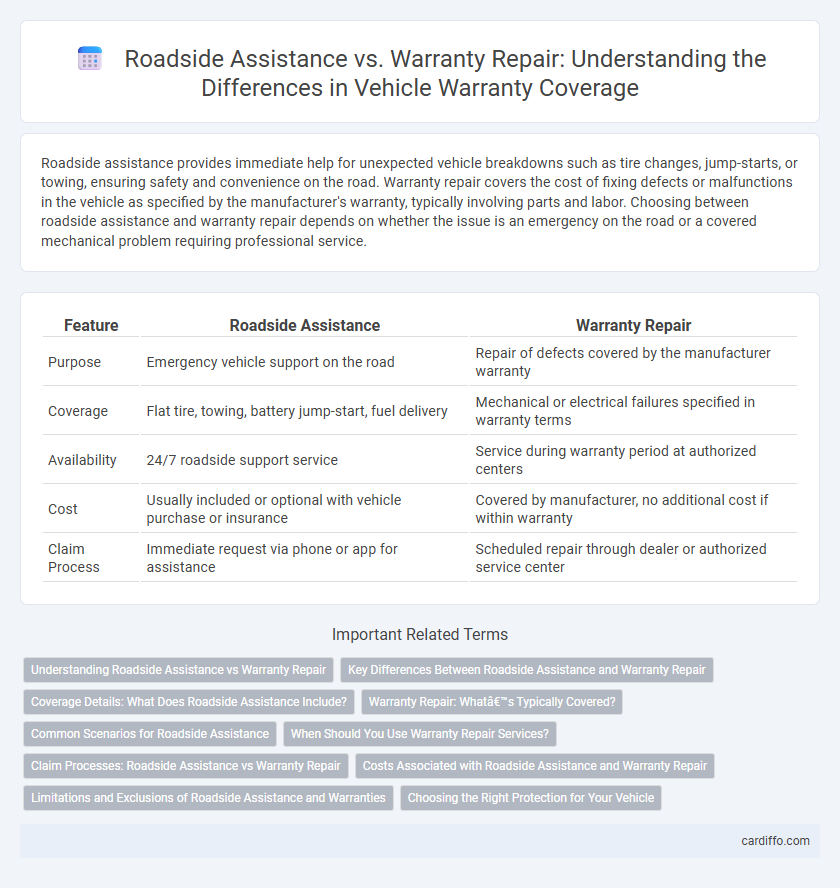Roadside assistance provides immediate help for unexpected vehicle breakdowns such as tire changes, jump-starts, or towing, ensuring safety and convenience on the road. Warranty repair covers the cost of fixing defects or malfunctions in the vehicle as specified by the manufacturer's warranty, typically involving parts and labor. Choosing between roadside assistance and warranty repair depends on whether the issue is an emergency on the road or a covered mechanical problem requiring professional service.
Table of Comparison
| Feature | Roadside Assistance | Warranty Repair |
|---|---|---|
| Purpose | Emergency vehicle support on the road | Repair of defects covered by the manufacturer warranty |
| Coverage | Flat tire, towing, battery jump-start, fuel delivery | Mechanical or electrical failures specified in warranty terms |
| Availability | 24/7 roadside support service | Service during warranty period at authorized centers |
| Cost | Usually included or optional with vehicle purchase or insurance | Covered by manufacturer, no additional cost if within warranty |
| Claim Process | Immediate request via phone or app for assistance | Scheduled repair through dealer or authorized service center |
Understanding Roadside Assistance vs Warranty Repair
Roadside assistance provides immediate help such as towing, battery jump-starts, and flat tire changes, typically covering unexpected breakdowns outside of repair shops. Warranty repair covers the cost of fixing defects or malfunctions in parts or workmanship as specified in the manufacturer's warranty terms, usually performed at authorized service centers. Understanding the distinction ensures consumers know when to use roadside assistance for emergency services versus relying on warranty repair for defect-related vehicle issues.
Key Differences Between Roadside Assistance and Warranty Repair
Roadside assistance provides immediate support for vehicle breakdowns such as towing, battery jump-starts, and lockout services, while warranty repair covers the cost of fixing defects or malfunctions in vehicle components under the manufacturer's warranty. Roadside assistance is typically time-limited and focused on emergency help outside normal repair services, whereas warranty repair involves scheduled maintenance or repairs authorized by the dealer or manufacturer. The key difference lies in the nature of service: roadside assistance addresses urgent, on-the-spot issues, whereas warranty repair resolves covered mechanical or electrical failures over a longer term.
Coverage Details: What Does Roadside Assistance Include?
Roadside assistance coverage typically includes emergency services such as towing, battery jump-start, flat tire change, lockout service, and fuel delivery within a specified radius. Warranty repair coverage, on the other hand, addresses the cost of repairs or replacements for defective parts and labor within the warranty period. Roadside assistance is designed for immediate help during vehicle breakdowns, while warranty repair ensures long-term vehicle reliability by covering manufacturer defects.
Warranty Repair: What’s Typically Covered?
Warranty repair typically covers defects in materials and workmanship for a specified period or mileage, ensuring repairs are performed at no cost to the vehicle owner. Common coverage includes engine and transmission issues, electrical system malfunctions, and faulty components critical to vehicle operation. Regular maintenance services and damages resulting from accidents or misuse are generally excluded from warranty repair coverage.
Common Scenarios for Roadside Assistance
Roadside assistance typically covers common scenarios such as flat tires, dead batteries, lockouts, and fuel delivery, providing immediate help when a vehicle becomes immobilized on the road. Warranty repair, in contrast, addresses defects and malfunctions covered under the vehicle's warranty, usually requiring service at an authorized repair facility. Roadside assistance acts as a first response to unexpected breakdowns, while warranty repair involves scheduled or necessary fixes to maintain vehicle performance and compliance.
When Should You Use Warranty Repair Services?
Warranty repair services should be utilized when a vehicle component experiences a defect or malfunction covered under the manufacturer's warranty terms. These services ensure that repairs are performed by certified technicians using genuine parts, preserving the vehicle's warranty and maintaining its resale value. Opt for warranty repair for issues related to engine performance, electrical systems, or covered mechanical failures to avoid out-of-pocket expenses.
Claim Processes: Roadside Assistance vs Warranty Repair
Roadside assistance claims typically require immediate reporting via phone or app, providing vehicle location and issue details for rapid dispatch of help services. Warranty repair claims involve submitting proof of warranty coverage and service authorization to the dealer or manufacturer before repairs commence. Both processes mandate thorough documentation, but roadside assistance prioritizes urgent response, while warranty repair focuses on validating coverage and compliance with repair guidelines.
Costs Associated with Roadside Assistance and Warranty Repair
Roadside assistance typically involves lower immediate costs, often included as part of a vehicle's warranty package or purchased separately for a fixed fee, covering services such as towing, battery jump-starts, and lockout help. Warranty repair costs vary depending on the vehicle manufacturer's coverage terms, typically covering parts and labor for defects without additional fees, but may exclude certain wear-and-tear components leading to out-of-pocket expenses. Understanding the distinctions between these cost structures helps vehicle owners manage potential expenses and maximize the value of their warranty and roadside assistance plans.
Limitations and Exclusions of Roadside Assistance and Warranties
Roadside assistance typically covers emergencies such as towing, battery jump-starts, and flat tire changes but excludes repairs or parts replacement, limiting its scope to immediate service rather than vehicle repair. Warranty repair, on the other hand, covers specific mechanical or electrical failures within the warranty period but often excludes wear-and-tear items, damage from accidents, and maintenance services. Both roadside assistance and warranty repairs come with geographic limitations, claim time restrictions, and require proper documentation to qualify for service.
Choosing the Right Protection for Your Vehicle
Roadside assistance provides immediate help during emergencies such as tire changes, towing, or lockouts, ensuring safety and convenience on the road. Warranty repair covers the cost of fixing defects or malfunctions in specific vehicle components, protecting against costly mechanical failures. Selecting the right protection involves evaluating your driving habits, vehicle age, and risk tolerance to balance emergency support with long-term repair coverage.
Roadside Assistance vs Warranty Repair Infographic

 cardiffo.com
cardiffo.com